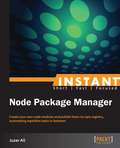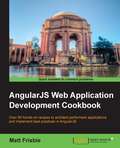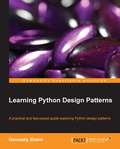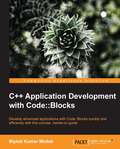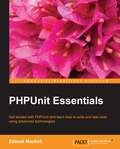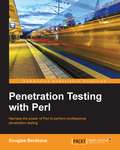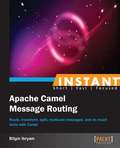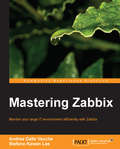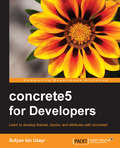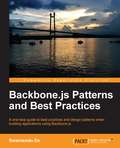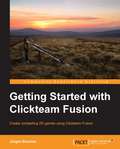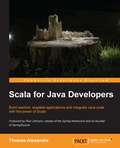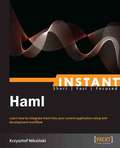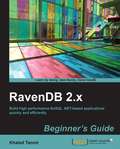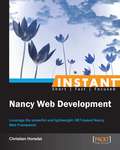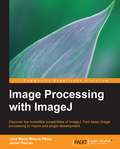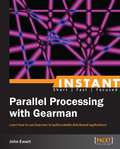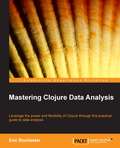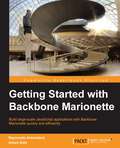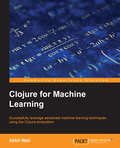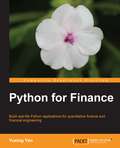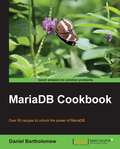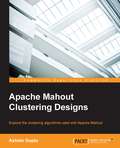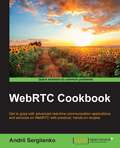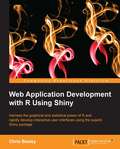- Table View
- List View
Instant Node Package Manager
by Juzer AliGet to grips with a new technology, understand what it is and what it can do for you, and then get to work with the most important features and tasks. A practical exploration of the lifecycle of creating node modules as well as learning all of the top features that npm has to offer.Intended for readers who want to create their first node.js modules. The programming paradigm of JavaScript is not covered so a foundation in these concepts would be beneficial.
AngularJS Web Application Development Cookbook
by Matt FrisbieThis is not your grandmother's JavaScript cookbook. If you have a foundational understanding of the framework and want to expand your AngularJS skillset with strategies and methodologies for building performant and scaleable production applications, this is the book for you. This book assumes you have an understanding of the basics of AngularJS, and experience with JavaScript.
Learning Python Design Patterns
by Gennadiy ZlobinThis book takes a tutorial-based and user-friendly approach to covering Python design patterns. Its concise presentation means that in a short space of time, you will get a good introduction to various design patterns.If you are an intermediate level Python user, this book is for you. Prior knowledge of Python programming is essential. Some knowledge of UML is also required to understand the UML diagrams which are used to describe some design patterns.
C++ Application Development with Code::Blocks
by Biplab Kumar ModakThis is a comprehensive tutorial with step-by-step instructions on how to develop applications with Code::Blocks.This book is for C++ developers who wish to use Code::Blocks to create applications with a consistent look and feel across multiple platforms. This book assumes that you are familiar with the basics of the C++ programming language.
PHPUnit Essentials
by Zdenek MachekThis book is a practical guide featuring a step-by-step approach that aims to help PHP developers who want to learn or improve their software testing skills. It also takes you through many reallife examples encountered by PHP developers to help you avoid common pitfalls. This book is a practical guide featuring a step-by-step approach that aims to help PHP developers who want to learn or improve their software testing skills. It also takes you through many reallife examples encountered by PHP developers to help you avoid common pitfalls.
Penetration Testing with Perl
by Douglas BerdeauxIf you are an expert Perl programmer interested in penetration testing or information security, this guide is designed for you. However, it will also be helpful for you even if you have little or no Linux shell experience.
Instant Apache Camel Message Routing
by Bilgin IbryamFilled with practical, step-by-step instructions and clear explanations for the most important and useful tasks. This short, instruction-based guide shows you how to perform application integration using the industry standard Enterprise Integration Patterns.This book is intended for Java developers who are new to Apache Camel and message- oriented applications.
Mastering Zabbix
by Andrea Dalle Vacche Stefano Kewan LeeWritten as a practical step-by-step tutorial, this book is full of engaging examples to help you learn in a practical context.If you are a system administrator or an IT architect and want to know how to better integrate your Zabbix installation with your surrounding environment, this book is ideal for you. A basic, working knowledge of Zabbix is assumed, so that the book can focus on how to take full advantage of every component. The code in the later chapter will be explained in its functionality, but basic programming skills are assumed as well.
concrete5 for Developers
by Sufyan Bin UzayrWhether you have had some previous experience with concrete5 or are entirely new to it, this book will help you understand all that you need to know in order to get started with concrete5 development. A background in PHP is required; some knowledge of HTML/CSS is needed in order to fully grasp the concepts underlying concrete5 theme development.
Backbone.js Patterns and Best Practices
by Swarnendu DeThis is a step-by-step guide to design patterns, best practices, and solutions to common problems for Backbone.js-based application development. This book is for JavaScript developers who work with Backbone.js and want to learn the best design patterns to develop complex web applications. Basic knowledge of Backbone.js and JavaScript is essential.
Getting Started with Clickteam Fusion
by Jürgen BrunnerAn easy-to-understand, step-by-step guide that shows you how to create 2D video games with Clickteam Fusion. You will learn the magic of game development from scratch without any knowledge of scripting languages. This book is for game enthusiasts who want to create their own 2D video games. No prior knowledge of programming or Multimedia Fusion 2 is necessary.
Scala for Java Developers
by Thomas AlexandreThis step-by-step guide is full of easy-to-follow code taken from real-world examples explaining the migration and integration of Scala in a Java project. If you are a Java developer or a Java architect, working in Java EE-based solutions and want to start using Scala in your daily programming, this book is ideal for you. This book will get you up and running quickly by adopting a pragmatic approach with real-world code samples. No prior knowledge of Scala is required.
Instant Haml
by Krzysztof NiksińskiisGet to grips with a new technology, understand what it is and what it can do for you, and then get to work with the most important features and tasks. A fast-paced, example-based guide to teach you how to integrate Haml into your Rails application.If you are a developer who would like to speed up and simplify your view template creation, this book is ideal for you. A basic working knowledge of HTML and CSS, as well as some Ruby on Rails experience is recommended.
RavenDB 2.x beginner's guide
by Khaled TannirWritten in a friendly, example-driven Beginner's Guide format, there are plenty of step-by-step instructions and examples that are designed to help you get started with RavenDB. If you are a .NET developer, new to document-oriented databases, and you wish to learn how to build applications using NoSQL databases, then this book is for you. Experience with relational database systems will be helpful, but not necessary.
Instant Nancy Web Development
by Christian HorsdalFilled with practical, step-by-step instructions and clear explanations for the most important and useful tasks.A practical, step-by-step guide featuring recipes that will get you up and running quickly with Nancy.A practical, step-by-step guide featuring recipes that will get you up and running quickly with Nancy.If you are a .NET oriented web developer who is curious to find out what lies beyond the Microsoft provided frameworks, then this book is for you! It's beneficial to have a good knowledge of C# and .NET, as well as a basic working knowledge of HTTP. If testability is important to you, and you're looking for a lightweight, code focused approach to building web applications, this book offers you all the guidance that you will need.
Image Processing with ImageJ
by Javier Pascau Jose Maria Mateos-PerezThe book will help readers discover the various facilities of ImageJ through a tutorial-based approach.This book is targeted at scientists, engineers, technicians, and managers, and anyone who wishes to master ImageJ for image viewing, processing, and analysis. If you are a developer, you will be able to code your own routines after you have finished reading this book. No prior knowledge of ImageJ is expected.
Instant Parallel processing with Gearman
by John EwartGet to grips with a new technology, understand what it is and what it can do for you, and then get to work with the most important features and tasks. This is a quick tutorial allowing you to quickly increase the efficiency of your system by intelligently reducing its workload where possible and learn techniques for designing your solutions to take advantage of Gearman's architecture.The technology covered in this book is usable by almost any modern programming language and any type of application, be it web, desktop, or mobile applications.This book targets developers who are interested in adding distributed data processing to their applications. The examples in this book are written using Ruby, but are documented thoroughly to allow developers comfortable with other languages to understand how to use them in a language of their choice. Intermediate programmers with no previous experience in distributed computing will also be able to easily follow the content.
Mastering Clojure Data Analysis
by Eric RochesterThis book consists of a practical, exampleoriented approach that aims to help you learn how to use Clojure for data analysis quickly and efficiently. This book is great for those who have experience with Clojure and need to use it to perform data analysis. This book will also be hugely beneficial for readers with basic experience in data analysis and statistics.
Getting Started with Backbone Marionette
by Raymundo Armendariz Arturo SotoThis book is written with an easy-to-understand approach with the intention of giving small but concrete examples that will help you to quickly understand each component of Marionette. Follow along as we work together to build a practical application using Backbone Marionette. If you are a web application developer interested in using Backbone Marionette for a real-life project, then this book is for you. As a prerequisite, knowledge of JavaScript and a working knowledge of Backbone.js is required.
Clojure for Machine Learning
by Akhil WaliA book that brings out the strengths of Clojure programming that have to facilitate machine learning. Each topic is described in substantial detail, and examples and libraries in Clojure are also demonstrated. This book is intended for Clojure developers who want to explore the area of machine learning. Basic understanding of the Clojure programming language is required, but thorough acquaintance with the standard Clojure library or any libraries are not required. Familiarity with theoretical concepts and notation of mathematics and statistics would be an added advantage.
Python for Finance
by Yuxing YanA hands-on guide with easy-to-follow examples to help you learn about option theory, quantitative finance, financial modeling, and time series using Python. Python for Finance is perfect for graduate students, practitioners, and application developers who wish to learn how to utilize Python to handle their financial needs. Basic knowledge of Python will be helpful but knowledge of programming is necessary.
MariaDB Cookbook
by Daniel BartholomewA practical cookbook, filled with advanced recipes , and plenty of code and commands used for illustration,which will make your learning curve easy and quick. This book is for anyone who wants to learn more about databases in general or MariaDB in particular. Some familiarity with SQL databases is assumed, but the recipes are approachable to almost anyone with basic database skills.
Apache Mahout Clustering Designs
by Ashish GuptaExplore clustering algorithms used with Apache Mahout About This Book * Use Mahout for clustering datasets and gain useful insights * Explore the different clustering algorithms used in day-to-day work * A practical guide to create and evaluate your own clustering models using real world data sets Who This Book Is For This book is for developers who want to try out clustering on large datasets using Mahout. It will also be useful for those users who don't have background in Mahout, but have knowledge of basic programming and are familiar with basics of machine learning and clustering. It will be helpful if you know about clustering techniques with some other tool. What You Will Learn * Explore clustering algorithms and cluster evaluation techniques * Learn different types of clustering and distance measuring techniques * Perform clustering on your data using K-Means clustering * Discover how canopy clustering is used as pre-process step for K-Means * Use the Fuzzy K-Means algorithm in Apache Mahout * Implement Streaming K-Means clustering in Mahout * Learn Spectral K-Means clustering implementation of Mahout In Detail As more and more organizations are discovering the use of big data analytics, interest in platforms that provide storage, computation, and analytic capabilities has increased. Apache Mahout caters to this need and paves the way for the implementation of complex algorithms in the field of machine learning to better analyse your data and get useful insights into it. Starting with the introduction of clustering algorithms, this book provides an insight into Apache Mahout and different algorithms it uses for clustering data. It provides a general introduction of the algorithms, such as K-Means, Fuzzy K-Means, StreamingKMeans, and how to use Mahout to cluster your data using a particular algorithm. You will study the different types of clustering and learn how to use Apache Mahout with real world data sets to implement and evaluate your clusters. This book will discuss about cluster improvement and visualization using Mahout APIs and also explore model-based clustering and topic modelling using Dirichlet process. Finally, you will learn how to build and deploy a model for production use. Style and approach This book is a hand's-on guide with examples using real-world datasets. Each chapter begins by explaining the algorithm in detail and follows up with showing how to use mahout for that algorithm using example data-sets.
WebRTC Cookbook
by Andrii SergiienkoIf you are a JavaScript developer with a basic knowledge of WebRTC and software development, but want to explore how to use it in more depth, this book is for you.
Web Application Development with R using Shiny
by Chris BeeleyThis book follows a standard tutorial-based approach which will teach you how to make a web app using R and Shiny quickly and easily.This book is for anybody who wants to produce interactive data summaries over the Web, whether you want to share them with a few colleagues or the whole world. You need no previous experience with R, Shiny, HTML, or CSS to begin using this book, although you will need at least a little previous experience with programming in a different language.
